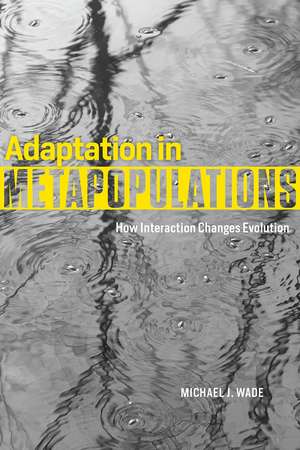Adaptation in Metapopulations: How Interaction Changes Evolution
Autor Michael J. Wadeen Limba Engleză Paperback – 3 mai 2016
All organisms live in clusters, but such fractured local populations, or demes, nonetheless maintain connectivity with one another by some amount of gene flow between them. Most such metapopulations occur naturally, like clusters of amphibians in vernal ponds or baboon troops spread across the African veldt. Others have been created as human activities fragment natural landscapes, as in stands of trees separated by roads. As landscape change has accelerated, understanding how these metapopulations function—and specifically how they adapt—has become crucial to ecology and to our very understanding of evolution itself.
With Adaptation in Metapopulations, Michael J. Wade explores a key component of this new understanding of evolution: interaction. Synthesizing decades of work in the lab and in the field in a book both empirically grounded and underpinned by a strong conceptual framework, Wade looks at the role of interaction across scales from gene selection to selection at the level of individuals, kin, and groups. In so doing, he integrates molecular and organismal biology to reveal the true complexities of evolutionary dynamics from genes to metapopulations.
With Adaptation in Metapopulations, Michael J. Wade explores a key component of this new understanding of evolution: interaction. Synthesizing decades of work in the lab and in the field in a book both empirically grounded and underpinned by a strong conceptual framework, Wade looks at the role of interaction across scales from gene selection to selection at the level of individuals, kin, and groups. In so doing, he integrates molecular and organismal biology to reveal the true complexities of evolutionary dynamics from genes to metapopulations.
Preț: 227.63 lei
Preț vechi: 272.88 lei
-17% Nou
Puncte Express: 341
Preț estimativ în valută:
43.56€ • 45.10$ • 36.82£
43.56€ • 45.10$ • 36.82£
Carte indisponibilă temporar
Doresc să fiu notificat când acest titlu va fi disponibil:
Se trimite...
Preluare comenzi: 021 569.72.76
Specificații
ISBN-13: 9780226129730
ISBN-10: 022612973X
Pagini: 240
Ilustrații: 21 halftones, 27 line drawings, 11 tables
Dimensiuni: 152 x 229 x 15 mm
Greutate: 0.37 kg
Ediția:1
Editura: University of Chicago Press
Colecția University of Chicago Press
ISBN-10: 022612973X
Pagini: 240
Ilustrații: 21 halftones, 27 line drawings, 11 tables
Dimensiuni: 152 x 229 x 15 mm
Greutate: 0.37 kg
Ediția:1
Editura: University of Chicago Press
Colecția University of Chicago Press
Notă biografică
Michael J. Wade is distinguished professor of biology at Indiana University, Bloomington. He is coauthor of Mating Systems and Strategies.
Cuprins
1 Introduction
2 What Is Group Selection?
3 Group Selection in the 1970s
4 Career Beginnings and Science after the Thesis
5 Experimental Studies of Population Heritability
6 Population Ecology and Population Heritability
7 The Evolution of Sociality
8 Calibrating the Laboratory to Nature
9 Experimental Studies of Wright’s Shifting Balance Theory
10 Beyond the Shifting Balancing Theory
Acknowledgments
Reference List
Index
2 What Is Group Selection?
3 Group Selection in the 1970s
4 Career Beginnings and Science after the Thesis
5 Experimental Studies of Population Heritability
6 Population Ecology and Population Heritability
7 The Evolution of Sociality
8 Calibrating the Laboratory to Nature
9 Experimental Studies of Wright’s Shifting Balance Theory
10 Beyond the Shifting Balancing Theory
Acknowledgments
Reference List
Index
Recenzii
“Adaptation in Metapopulations is a multifaceted, deeply considered discussion of the current state of our understanding of how evolution proceeds within and among connected populations, including metapopulations and other kinds of groups. It is also a book on whether and how natural selection may act at multiple group levels, rather than solely at the level of selection among individuals. In that sense it evaluates our understanding of the conditions under which group selection could occur. Conceived and written in a unique way, it is simultaneously a synthesis of work on some major scientific questions, a summary of the history of that work, and a personal memoir on Wade’s intellectual trajectory as he probed those questions, all from a scientist who has spent a major part of his career near the center of these discussions, experiments, and controversies.”
“How do organisms (individuals, kin, or groups) interact, and how does natural selection work? These are the questions Wade attempts to answer. . . . The book is arranged chronologically, starting with his earliest work from the 1970s, and ends with a paper published in 2012. Wade incorporates some biographical details of his own life, usually at the start of a chapter, and then adds thorough descriptions of the work that he, his peers, and his graduate students have conducted. . . . The book is illustrated with very clear diagrams and a few black-and-white photographs. References from the text are arranged alphabetically in a separate section, and the book includes a detailed index. Recommended.”
